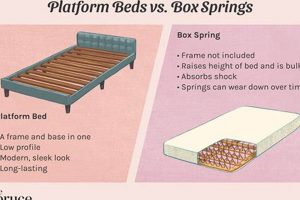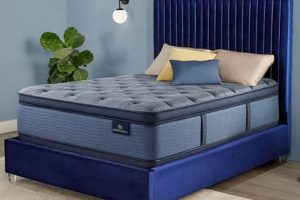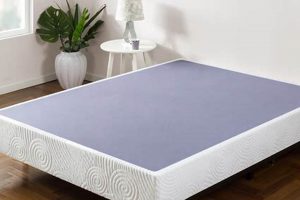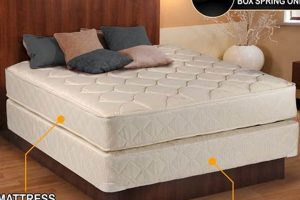A supportive foundation is paramount for optimal performance and longevity of modern sleep surfaces, including those incorporating a combination of materials like coils and foam. The necessity of a traditional spring-based support system is no longer a universal requirement for these mattresses.
Adequate support prevents premature sagging, maintains proper spinal alignment, and ensures the warranty remains valid. Historically, spring systems were essential to provide the necessary support for innerspring mattresses. However, advances in mattress design and alternative foundation options have broadened the possibilities.
Considerations such as the manufacturer’s recommendations, the type of bed frame, and the individual’s weight and preferences play a crucial role in determining the appropriate foundation. Exploring suitable alternatives and understanding their benefits provides a clearer path toward achieving optimal sleep and mattress support.
Tips for Selecting a Foundation for a Hybrid Mattress
Selecting the appropriate foundation for a hybrid mattress requires careful consideration. These guidelines offer valuable insight for ensuring optimal support and extending the lifespan of the mattress.
Tip 1: Consult Manufacturer Guidelines: Always review the mattress manufacturer’s recommendations regarding compatible foundations. These guidelines specify acceptable foundation types and may impact warranty validity.
Tip 2: Evaluate Bed Frame Compatibility: Verify that the chosen foundation is compatible with the existing bed frame. Some frames may require specific foundation heights or styles for proper support and aesthetic integration.
Tip 3: Consider Weight Distribution: Account for the combined weight of the mattress and sleepers. Heavier individuals may require a more robust foundation to prevent sagging and maintain proper support.
Tip 4: Explore Alternative Foundations: Investigate platform beds, adjustable bases, and solid or slatted foundations as potential alternatives to traditional spring systems. Each option offers distinct advantages and levels of support.
Tip 5: Assess Slatted Foundation Spacing: If choosing a slatted foundation, ensure that the slats are closely spaced (typically no more than 2-3 inches apart). Wider spacing can lead to uneven support and potential mattress damage.
Tip 6: Inspect Foundation Quality: Prioritize foundations constructed from durable materials with reinforced frames. A well-built foundation provides long-lasting support and stability.
Tip 7: Factor in Personal Preference: Consider personal preferences for bed height and firmness when selecting a foundation. The foundation can influence the overall feel and comfort of the mattress.
Following these guidelines will contribute to selecting a foundation that provides adequate support, enhances sleep quality, and prolongs the life of the hybrid mattress.
These considerations are crucial for optimizing the performance and longevity of the mattress investment.
1. Manufacturer's recommendations
The manufacturer’s recommendations serve as a primary determinant in deciding whether a spring system is needed for a hybrid mattress. These guidelines are established based on rigorous testing and engineering considerations to ensure optimal support and longevity of the specific mattress model. Deviating from these recommendations can directly impact the mattress’s performance and invalidate the warranty.
For example, some manufacturers may specify that their hybrid mattress models are designed for use with solid platform bases or adjustable frames, rendering a spring system unnecessary or even detrimental. Conversely, others may indicate that a particular type of spring system is required to provide adequate support, particularly for heavier individuals or specific sleeping positions. Neglecting to adhere to these guidelines can lead to uneven weight distribution, premature sagging, and a compromised sleep experience.
In conclusion, careful attention to the manufacturer’s recommendations is essential. These guidelines offer critical insights into the required foundation type for a hybrid mattress. Ignoring these directives often results in diminished mattress performance, voided warranties, and an overall reduction in the value of the mattress investment.
2. Foundation Alternatives
The decision to forgo a traditional spring system for a hybrid mattress is intrinsically linked to the availability and suitability of alternative foundation options. These alternatives directly impact the level of support provided, the longevity of the mattress, and, ultimately, the quality of sleep. Platform beds, adjustable bases, and slatted foundations each present unique advantages and disadvantages when considered in the context of a hybrid mattress.
For example, a solid platform bed offers consistent, uniform support, often eliminating the need for a spring system. However, it may limit airflow and potentially trap heat within the mattress. Conversely, an adjustable base provides customizable support and elevation, beneficial for individuals with specific health conditions, but may be more expensive. Slatted foundations, when constructed with appropriately spaced and sturdy slats, can offer adequate support while promoting airflow. The crucial factor remains the ability of the chosen alternative to provide the necessary structural integrity to prevent sagging and maintain proper spinal alignment, thus acting as the functional equivalent of a traditional spring-based support.
The proliferation of these alternative foundation options has diminished the absolute necessity of a traditional spring system for hybrid mattresses. The critical consideration shifts from default inclusion to a careful evaluation of available substitutes and their ability to fulfill the foundational requirements of the specific hybrid mattress model, in order to support the manufacturer’s recommendations and avoid the invalidation of warranties. The understanding and consideration of foundation alternatives are crucial.
3. Warranty Requirements
Warranty requirements constitute a critical factor in determining the necessity of a spring system for hybrid mattresses. Mattress warranties often contain specific stipulations regarding the type of foundation used, and non-compliance can result in voiding the warranty, regardless of other factors.
- Approved Foundation Types
Mattress manufacturers typically list approved foundation types within the warranty documentation. These may include specific platform beds, adjustable bases, or spring systems meeting certain criteria. Using an unapproved foundation, even if it appears structurally sound, may invalidate the warranty if the mattress develops sagging or other issues attributed to inadequate support.
- Support System Specifications
Warranties may specify minimum requirements for the support system, such as the spacing of slats on a slatted foundation or the height and construction of a spring system. For instance, a warranty might require slats to be no more than two inches apart or mandate the use of a spring system with a certain number of coils and gauge of wire. Failure to adhere to these specifications can void the warranty if the mattress exhibits signs of insufficient support.
- Documentation and Proof of Compliance
In the event of a warranty claim, manufacturers may request proof that the mattress was used with an approved foundation meeting all specified requirements. This may involve providing receipts for the foundation or photographic evidence of its construction and compliance with the warranty terms. Lack of such documentation can jeopardize the warranty claim.
- Impact of Foundation on Mattress Longevity
Warranty provisions often reflect the manufacturer’s assessment of how different foundation types affect mattress longevity. The manufacturer’s research informs the warranty requirements, aiming to minimize premature wear and tear. Therefore, the decision on foundation must consider both immediate support and long-term warranty implications.
Therefore, careful review of the mattress warranty is essential before selecting a foundation. Ignoring the warranty requirements risks losing coverage for potential defects or premature wear, ultimately increasing the overall cost of mattress ownership. Understanding and complying with these terms is paramount.
4. Mattress Support
Mattress support is inextricably linked to the question of whether a spring system is necessary for a hybrid mattress. The primary function of any foundation is to provide adequate support to the mattress, preventing sagging and ensuring proper spinal alignment for the sleeper. In the context of hybrid mattresses, which combine innerspring coils with foam layers, the support provided by the foundation becomes particularly crucial due to the combined weight and varying densities of the materials. An insufficient foundation leads to uneven weight distribution, accelerating wear and tear on the mattress, potentially invalidating the warranty, and negatively impacting sleep quality. For example, using a flimsy slatted foundation with wide gaps under a heavy hybrid mattress can cause the foam layers to compress unevenly and the coils to lose their integrity, resulting in discomfort and reduced mattress lifespan.
Alternative foundation options, such as platform beds or adjustable bases, offer varying degrees of support. A solid platform bed provides uniform support across the entire mattress surface, effectively mimicking the function of a traditional spring system. Adjustable bases, while offering customizable support and elevation, must be structurally sound to handle the weight and movement of the hybrid mattress without compromising its integrity. The choice of foundation directly influences the long-term performance and comfort of the hybrid mattress; therefore, assessing the level of support each option provides is paramount. A hybrid mattress on a bed frame without sufficient central support, for instance, will sag prematurely in the middle, regardless of the quality of the mattress itself.
In conclusion, adequate mattress support is a non-negotiable requirement for maximizing the lifespan and performance of a hybrid mattress. While a traditional spring system is one option, the determining factor is whether the chosen foundationbe it a spring system or an alternativeeffectively distributes weight, prevents sagging, and maintains proper spinal alignment. The absence of adequate support, regardless of the foundation type, invariably leads to premature mattress failure and compromised sleep quality. Understanding the practical significance of matching foundation support to the specific needs of the hybrid mattress ensures a more comfortable and durable sleep solution.
5. Bed Frame Compatibility
Bed frame compatibility significantly influences the determination of whether a spring system is required for a hybrid mattress. The design and structure of the bed frame directly impact the level of support provided to the mattress, thus affecting its performance and longevity.
- Slatted Bed Frames and Support Requirements
Slatted bed frames necessitate careful evaluation regarding their support capabilities. The spacing and strength of the slats are critical. Wide gaps between slats may not provide adequate support, potentially leading to mattress sagging and voiding the warranty. Hybrid mattresses, with their combination of coils and foam, require consistent support to prevent uneven compression. If the slats are insufficient, a spring system or a bunkie board may be necessary to provide a solid, even surface.
- Platform Bed Frames as Direct Support
Platform bed frames often eliminate the need for a traditional spring system. These frames feature a solid or closely spaced slatted surface that directly supports the mattress. The solid surface ensures even weight distribution and prevents sagging. However, the platform’s material and construction must be robust enough to handle the weight of the hybrid mattress and the occupants to maintain long-term structural integrity.
- Headboard and Footboard Attachment Considerations
The method of attaching a headboard and footboard can indirectly impact the need for a spring system. Some bed frames require a spring system to provide the necessary height for aesthetic consistency and to properly support the mattress within the frame. Without a spring system, the mattress may sit too low, creating an undesirable appearance and potentially affecting the comfort and ease of getting in and out of bed.
- Adjustable Bed Frame Integration
Adjustable bed frames present a unique consideration. These frames are designed to articulate and provide customized support. Traditional spring systems are generally incompatible with adjustable frames. Instead, hybrid mattresses are placed directly on the adjustable base. The mattress must be flexible enough to conform to the frame’s movements without damage, and the frame must provide sufficient support in all positions.
The selection of a bed frame should be based on its ability to adequately support the hybrid mattress and meet the manufacturer’s warranty requirements. While some bed frames may negate the need for a spring system, others may necessitate additional support to ensure optimal mattress performance and longevity.
Frequently Asked Questions
This section addresses common inquiries regarding the necessity of a spring system for hybrid mattresses. It provides factual answers to assist in making informed decisions about mattress support.
Question 1: Does a hybrid mattress always require a spring system?
No, the necessity of a spring system depends on the manufacturer’s recommendations, the type of bed frame, and the desired level of support. Platform beds and adjustable bases can serve as suitable alternatives, potentially negating the need for a spring system.
Question 2: What happens if a hybrid mattress is used without adequate support?
Inadequate support can lead to premature sagging, uneven weight distribution, and potential voiding of the mattress warranty. It can also negatively impact spinal alignment and overall sleep quality.
Question 3: How does the warranty influence the choice of foundation for a hybrid mattress?
Mattress warranties often specify approved foundation types. Using an unapproved foundation can invalidate the warranty if support-related issues arise. Review the warranty carefully before selecting a foundation.
Question 4: Are slatted foundations suitable for hybrid mattresses?
Slatted foundations can be suitable if the slats are closely spaced (typically no more than 2-3 inches apart) and sufficiently strong to provide adequate support. Wide gaps between slats can lead to uneven support and potential mattress damage.
Question 5: What are the benefits of using a platform bed with a hybrid mattress?
Platform beds offer consistent, uniform support across the entire mattress surface, eliminating the need for a spring system in many cases. This can also improve the mattresss longevity and prevents sagging.
Question 6: Can an adjustable base be used with a hybrid mattress?
Yes, most hybrid mattresses are compatible with adjustable bases. However, ensure that the adjustable base provides adequate support in all positions and that the mattress is flexible enough to conform to the base’s movements without damage.
In summary, determining the appropriate foundation hinges on the interplay of manufacturer guidelines, warranty stipulations, and the physical support requirements of the hybrid mattress. Carefully evaluating these factors ensures optimal performance and longevity.
Next, we will provide a checklist to summarize key points regarding hybrid mattress support systems.
Conclusion
The preceding analysis clarifies that the need for a spring system in conjunction with a hybrid mattress is not absolute. The decision hinges on a confluence of factors, including manufacturer specifications, warranty requirements, the type of bed frame utilized, and the desired level of support. Alternative foundation options, such as platform beds and adjustable bases, often present viable substitutes. Proper evaluation of these elements ensures optimized mattress performance and lifespan.
Therefore, a considered approach, informed by the aforementioned criteria, is paramount when selecting a foundation. Failure to adequately assess these factors may result in compromised support, voided warranties, and reduced mattress longevity. Further research and adherence to manufacturer guidelines are strongly encouraged to maximize the return on investment and guarantee a satisfactory sleep experience.





![Best Box Spring & Mattress Queen Set [Deals!] Organic & Natural Mattress Buyer’s Guide: Non-Toxic Sleep Solutions Best Box Spring & Mattress Queen Set [Deals!] | Organic & Natural Mattress Buyer’s Guide: Non-Toxic Sleep Solutions](https://mattressworldpa.com/wp-content/uploads/2025/07/th-3396-300x200.jpg)

![Best California King Mattress With Box Spring [Guide] Organic & Natural Mattress Buyer’s Guide: Non-Toxic Sleep Solutions Best California King Mattress With Box Spring [Guide] | Organic & Natural Mattress Buyer’s Guide: Non-Toxic Sleep Solutions](https://mattressworldpa.com/wp-content/uploads/2025/07/th-3394-300x200.jpg)